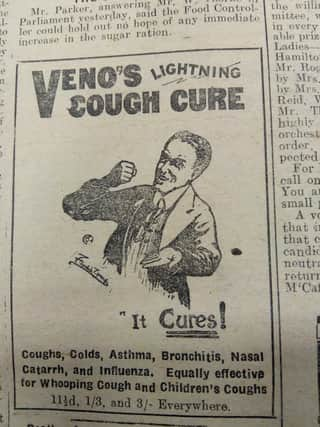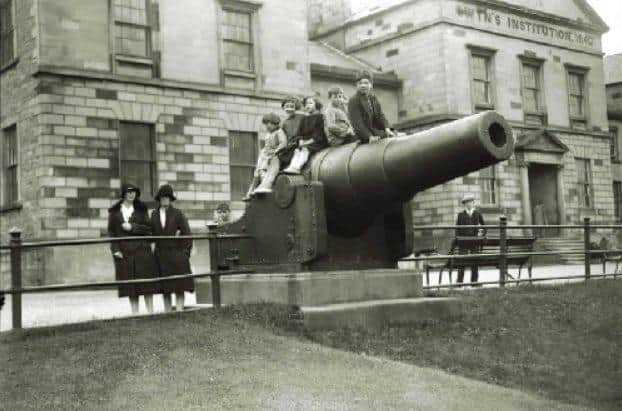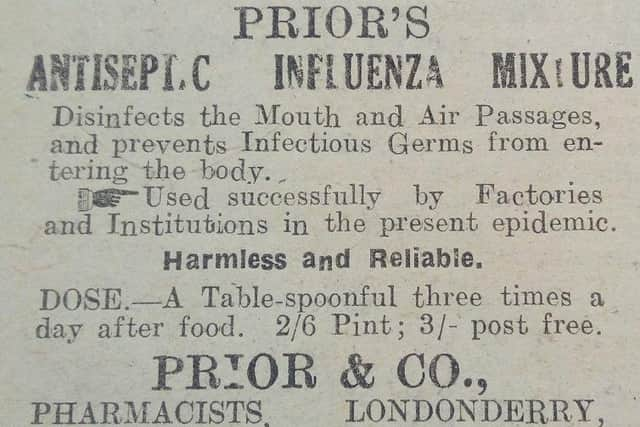The Spanish ‘flu of 1918: ‘The malady has spread to Derry, enormous numbers are laid up’


Spanish ‘flu, which we now know to have been a particularly virulent pandemic of the H1N1 influenza virus, first arrived in Ireland in May 1918.
Three lethal waves of the illness later and 800,000 people in Ireland had been infected, over 20,000 were dead, and Derry had suffered its own toll.
Advertisement
Hide AdAdvertisement
Hide AdWhen the disease first landed on these shores towards the end of the First World War there was a great deal of confusion about what was happening.


In early May the ‘Journal’ carried a report on a debate in the Westminster Parliament during which it was revealed that “an investigation was underway into the occurrence of an obscure disease resembling Botulism”.
There was, however, no more significant reportage of the strange outbreak until June 1918 when Derry was truly in the grip of the epidemic.
“The malady has spread to Derry and on Monday it was ascertained from a doctor that there was an enormous number of people in the city confined to bed as a result of the epidemic. In one home the mother and six children are affected.
Advertisement
Hide AdAdvertisement
Hide Ad“There are numerous cases in the soldiers’ barracks’ at the Waterside, and in consequence the men have been confined to barracks.


“Many workers in the factories and shipyard are laid up, and on Monday it was stated that 14 assistants in the Post Office were out suffering from the ailment.
“The school in the city, which had been closed in consequence of the measles, re-opened on Monday, and closed again yesterday,” the ‘Journal’ reported on Wednesday, June 26, 1918.
An editorial in the same edition puzzled over ‘The Mystery Epidemic’ that was having such a profound impact in the city and district.
Advertisement
Hide AdAdvertisement
Hide Ad“What has been styled ‘the mystery illness’ for the past six weeks or more has been placing and continues to place, large numbers of people on ‘the sick list.’
“Is the malady directly due to the war? Is it only partially due thereto? Or has it (as the Scottish story says) ‘descended on the honest folk’ quite distinct from and irrespective of the belligerent turmoil?” the leader article asked.
It referred to how many people had correctly deduced that the illness had been borne back to Ireland from the war in Europe and was even being described as ‘trench fever.’
The paper described how the ‘flu had first got a firm foothold in Belfast but had soon made its way westward.
Advertisement
Hide AdAdvertisement
Hide Ad“Soon afterwards it ‘made its presence unpleasantly felt’ in Derry City, where at present there are many patients - military and civilian - temporarily laid aside in hospital camp or home.”
The writer’s connection of the ‘flu with the war was astute but perhaps not in the way that was meant.
Then, as today, there was a lot of wrong-headed misinformation doing the rounds.
By the time of the second, more deadly wave of the virus in the autumn of 1918 the ‘Journal’ reported how some people thought it may have been linked to the use of poison gases and bombs in the war.
Advertisement
Hide AdAdvertisement
Hide AdThe paper carried a Reuters wire from Shanghai that stated: “Influenza is raging in China. The Chinese believe that the disease is due to the contamination of the world’s atmosphere by the use of gas and other explosives in Europe.”
By October things were clearly getting worse and the influenza epidemic was receiving an equal billing with the dramatic events in Ireland, where support for Sinn Féin was surging, and in Europe, where the First World War was coming to an end.
On Monday, October 28, in a report on ‘the influenza scourge’ the ‘Journal’ carried a worryingly apocalyptic statement from Cardinal Michael Logue that “expressed the hope that humanity might be spared the great physical evils that in the Middle Ages usually followed in the train of devastating wars.”
There were many personal tragedies. On October 30, the ‘Journal’ reported on an ‘increasing roll of victims’ and how “Mr. Thomas Kendall, Board of Trade Surveyor in Derry, has suffered a double bereavement by the death of his wife at his residence in Derry, and of his daughter, who died in London.”
Advertisement
Hide AdAdvertisement
Hide AdOn November 11, alongside reports of the end of the war and the ‘overthrow of the German dynasty’ the tragic death of a Derry nurse from the illness was reported.
“At Derry Guardians’ meeting on Saturday the Master reported the death from pneumonia following influenza of Probationer Nurse McDermott.
“The Board expressed deep sympathy with Nurse McDermott’s relatives. The medical officer reported that another nurse was suffering from pneumonia consequent of an attack of influenza.
“In view of the large number of patients in hospital he suggested that an apothecary be appointed to visit the institution daily to mix and prepare the necessary medicines for the sick.”
Advertisement
Hide AdAdvertisement
Hide AdAnd on November 13, the city fathers of the day grappled with how to respond to a severe influenza outbreak that was also compounded by outbreaks of typhus and scarlet fever in Derry and Donegal.
During a meeting of the standing committees of the Corporation there were calls for public entertainments to be called off and for Gwyn’s Institute in Brooke Park to be staffed as a specialist influenza hospital.
“Alderman Bible said there was a serious outbreak of influenza, and he suggested that public entertainments should be abandoned for the present.
“They Mayor [Robert Newton Anderson] said they had done everyhing they possibly could to combat the epidemic.”
Advertisement
Hide AdAdvertisement
Hide AdHowever, several councillors felt more could be done to address the outbreak.
“Alderman Bible said the public entertainments should be closed until the epidemic was stamped out. Alderman Dr. Elliott said he did not think it was greatly known that there was not a place in the city for the treatment of influenza patients. If he had a case not complicated he had no place to send it.
“Councillor McGahey - It is disgraceful.
“Alderman Elliott said he did not see why they should not organise and staff Gwyn’s Institute for the treatment of influenza cases.
“It would cost money, but the lives of the citizens were more important.
Advertisement
Hide AdAdvertisement
Hide Ad“In small poisoned rooms the chance of recovery without complications was very limited.”
It wasn’t just in Derry that the deadly ‘flu was having a devastating effect and the ‘Journal’ carried reports from down the country and abroad.
The paper informed its readership that Dr. A. Conan Doyle, the son of Arthur Conan Doyle, the creator of Sherlock Holmes, had died in St. Thomas’s Hospital in London from the illness.
Dundalk was suffering very severely: 2,000 people were laid up and there had been “scores of deaths from pneumonia following the influenza.”
Advertisement
Hide AdAdvertisement
Hide AdIn Dublin, over one weekend, there were 108 burials in Glasnevin and 180 members of the Dublin Metropolitan Police were sick.
“The public is apparently becoming nervous about going to places of amusement, as the audiences are not nearly so numerous as they were a week ago.
“The streets have been sprayed with a solution of Jeyes Fluid and carbolic, and householders are urged to use carbolic for domestic flushing purposes, with a view to preventing infection.”
A third wave of Spanish ‘flu ravaged Ireland in January 1919 before disappearing in the spring.
Advertisement
Hide AdAdvertisement
Hide AdThe death toll in Ireland had been horrendous but the global scale of the disease was truly terrifying.
It’s estimated that the virus infected 500 million people and killed three to five per cent of the world’s population.